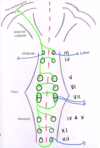Descending Motor Pathways Flashcards
(91 cards)
What are motor pathways divided into?
Upper and lower motor neuron regions (UMN and LMN)

Where do UMNs originate? Where do they end?
- Originate in the cerebrum and subcortical structures
- End/synapse in spinal cord or brainstem
- Synapse with cranial nerve nuclei in brainstem which then go on to supply head
- Synapse in spinal cord with nuclei that go on to supply the body

Function of UMNs?
- Influence LMN activity
- Modify local reflex activity
- Superimpose more complex patterns of movement
Where do LMNs originate?
Brainstem or spinal cord (ventral grey horn)

What are motor end plates?
Also called neuromuscular junctions - specialised chemical synapses formed at the sites where the terminal branches of the axon of a motor neuron contact a target muscle cell.
Where does the cell body of a LMN lie?
Within the ventral horn of the spinal cord OR the brainstem motor nuclei of the cranial nerves (within the CNS)
After the axon of a LMN exits the CNS, it forms the somatic motor part of the PNS. Where does it terminate?
On the muscle fibres which it innervates.
N.B. It is important to note that although one LMN will innervate several muscle fibres, a single muscle fibre is innervated by only one LMN.
What is released by LMNs at the neuromuscular junction (NMJ)? What does this cause?
The neurotransmitter acetylcholine, which causes firing of an action potential in the receiving muscle fibre.
What is acetylcholine? Function?
The chief neurotransmitter of the parasympathetic nervous system, the part of the autonomic nervous system (a branch of the peripheral nervous system) that contracts smooth muscles, dilates blood vessels, increases bodily secretions, and slows heart rate.
Cross section through spinal cord. Sensory info enters via dorsal root. How does motor info leave the spinal cord?
Cell bodies of LMNs found in ventral grey horn. Axons (efferent fibres) then exit via the ventral root to go towards muscle

Different types of descending motor pathways:
N.B. the name of the pathway tells you the origin and destination of the pathway

The motor tracts can be functionally divided into two major groups: Pyramidal tracts and Extrapyramidal tracts.
Describe the origin and function of both of these tracts.
- Pyramidal:
- These tracts originate in the cerebral cortex
- Carry motor fibres to the spinal cord and brain stem
- They are responsible for the voluntary control of the musculature of the body and face.
- Extrapyramidal:
- These tracts originate in the brain stem
- Carry motor fibres to the spinal cord
- They are responsible for the involuntary and automatic control of all musculature, such as muscle tone, balance, posture and locomotion
Where do the pyramidal tracts derive their name from?
the medullary pyramids of the medulla oblongata, which they pass through

Functionally, the pyramidal tracts can be subdivided into two. What are these?
- Corticospinal tracts
- Corticobulbar/corticonuclear tracts
What do the corticospinal tracts supply?
Supplies the musculature of the body.
Where do the corticospinal tracts originate/terminate?
- Originate in cerebral cortex
- After originating from the cortex, the neurones converge, and descend through the internal capsule
- Then the neurones pass through the crus cerebri of the midbrain, the pons and into the medulla.
- Terminate in ventral horn of spinal cord

Where do the corticonuclear tracts orignate/terminate?
- Arise from the lateral aspect of the primary motor cortex
- The fibres converge and pass through the internal capsule to the brainstem.
- The neurones terminate on the motor nuclei of the cranial nerves
- Here, they synapse with lower motor neurones, which carry the motor signals to the muscles of the face and neck.

What is the internal capsule?
A white matter pathway, located between the thalamus and the basal ganglia
Why is the internal capsule clinically relevant?
The internal capsule is particularly susceptible to compression from haemorrhagic bleeds, known as a ‘capsular stroke‘. Such an event could cause a lesion of the descending tracts.
What are the 4 extrapyramidal tracts?
- Vestibulospinal Tracts
- Reticulospinal Tracts
- Rubrospinal Tracts
- Tectospinal Tracts
The extrapyramidal tracts originate in the brainstem, carrying motor fibres to the spinal cord.
What are the extrapyramidal tracts responsible for?
They are responsible for the involuntary and automatic control of all musculature, such as muscle tone, balance, posture and locomotion.
Where do the reticulospinal tracts originate/terminate?
Originate in the reticular formation.
Terminates in spinal cord.
Where do the vestibulospinal tracts originate/terminate?
Originate in vestibular nuclei in brainstem.
Terminate in spinal cord.
Where do the tectospinal tracts originate/terminate?
Originate in tectum of brainstem.
Terminate in spinal cord.







































